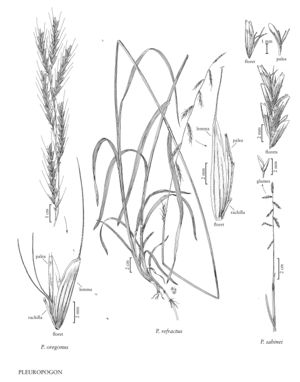Pleuropogon oregonus
Plants perennial; not cespitose, rhizomatous. Culms 40-95 cm tall, 2-3.5 mm thick, erect. Sheaths glabrous, smooth or scabridulous; ligules 5-10 mm, rounded or acute, often erose; blades 5-17 cm long, 4-9 mm wide, smooth or scabridulous over the veins, apices spinose. Racemes 13-20 cm, with 6-7 spikelets; lower internodes 3.5-7.2 cm; upper internodes shorter; pedicels 2-5 (12) mm. Spikelets 20-40 (50) mm, with 7-14 florets, lower florets bisexual, upper florets pistillate, terminal florets usually sterile. Glumes lanceolate to ovate, acute, erose; lower glumes 2-3 mm; upper glumes 2.5-4.5 mm; rachilla internodes 2-3 mm long, 0.1-0.2 mm thick, without a glandular swelling at the base; lemmas 5.5-7 mm, scabridulous, 7-veined, veins prominent, apices truncate, sometimes erose, awned, awns 5-12 mm; paleal keels awned, awns 3-9 mm, inserted 1/3 – 1/2 of the way from the base; anthers about 4 mm. Caryopses 2.5-3 mm. 2n = unknown.
Discussion
Pleuropogon oregonus grows in swampy ground, wet meadows, and stream banks. It is known, even historically, from only a few locations in Union and Lake counties, Oregon. In 1975 it was thought to be extinct, but a population has since been discovered at one location in Lake County. The species is listed as threatened by the state of Oregon.
Selected References
None.
Lower Taxa
"decumbent" is not a number.
